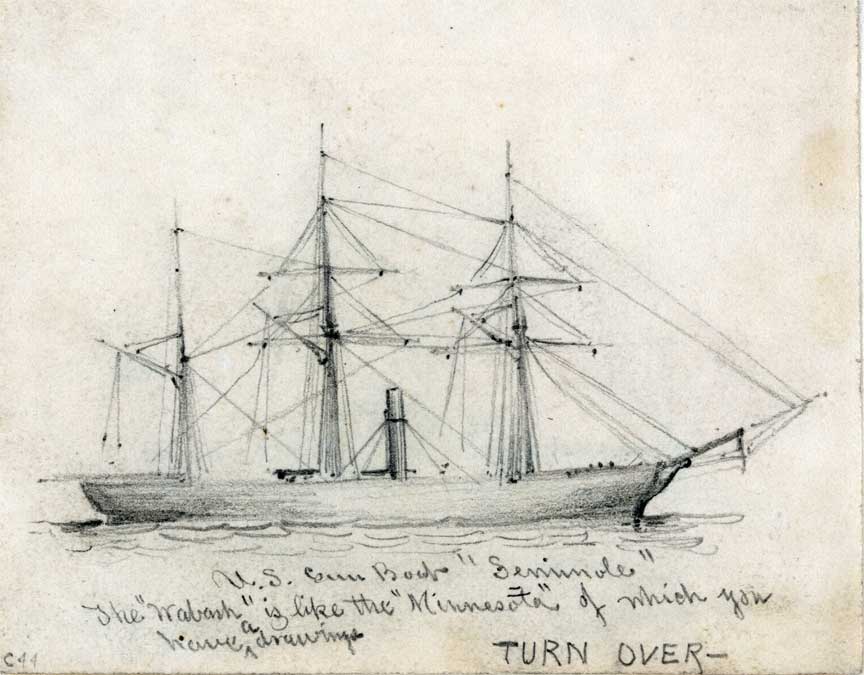
Seminole II
(ScSlp: t. 801; 1. 188'; b. 30'6"; cpl. 120, a. 1 11" D.
sb., 1 30-pdr. P.r., 6 32-pdrs., 1 light 12 par.)
The first Seminole was launched by the Pensacola Navy Yard on 25 June 1859, sponsored by Miss Mary Dallas, and was commissioned there on 25 April 1860 Comdr. Edward R. Thomson in command.
The new screw sloop of war sailed for Brazil on 16 July 1860 and served on the Brazil station until called home soon after the outbreak of the Civil War. The ship departed Rio de Janiero on 23 May 1861 and reached Philadelphia on 6 July.
Rapidly fitted out for blackade duty, Seminole was ordered on 16 July to proceed to Hampton Roads. After reporting for duty in the Atlantic Blockading Squadron, the ship sailed, via Charleston, S.C., for Savannah Ga. Upon exhausting her coal on blockade duty off that port, the ship sailed for Hampton Roads on 19 August, towing prize schooner, Albion, and arrived off Newport News on the 23d. A week later, on 30 August, Confederate tug, Harmony, attacked Union sailing sloop of war, Savannah, there. Seminole was in the vicinity and returned the fire, but her shells did not reach the Southern ship.
On 9 September, Seminole and Rescue sailed for the Potomac to check the threat posed by the concentration of a large Confederate force on the south bank of the river below Alexandria. On the 21st, a boat from Seminole captured sloop, Maryland, in the Potomac. Four days later, Seminole and Jacob Bell engaged a Confederate battery at Freestone Point, Va. After repairs at the Washington Navy Yard, Seminole returned to Hampton Roads on 16 October where she awaited the arrival of Flag Officer DuPont, commander of the newly established South Atlantic Blockading Squadron.
On 7 November, Seminole was in the task force which captured Port Royal, S.C. The ships bombarded forts Walker and Beauregard and forced the Confederates to abandon them. This gave the Union Navy an invaluable base for blockade operations off South Carolina, Georgia, and Florida. On 1 December 1861, Seminole seized sloop, Lida, off St. Simon's Sound, Gal, attempting to slip into the South laden with coffee lead, and sugar from Havana, Cuba. Early in March, Seminole participated in the expedition which captured Fernandia, Fla.
On 25 March 1862, Seminole was ordered to Hampton Roads to strengthen Union naval forces there which were threatened by the dreaded Confederate ironclad, Virginia. Control of these strategic waters was especially important at that time because General MeClellan was about to launch his Peninsular Campaign against the Southern capital, Richmond. On 8 May, Seminole joined Monitor, Dacotah, Naugatuck and Susquchanna in shelling Confederate batteries at Sewell's Point, Va. In response, Virginia came out, but not far enough to be rammed. Norfolk was soon abandoned by Southern troops. Late in June, Seminole was ordered to the New York Navy Yard for repairs.
The ship was recommissioned on 8 June 1863 and assigned to the West Gulf Blockading Squadron. En route south, she captured Confederate steamer, Charleston, on 11 July. On 11 September, she took steamer Sir William Peel, off the mouth of the Rio Grande. This British merchantman was carrying 1,000 bales of cotton at the time of her capture.
The high point of her service in the West Gulf Blockading Squadron came on 5 August 1964 when she participated i n the Battle of Mobile Bay. She passed the forts guarding the entrance to the bay lashed to Lackawanna but, as the action became general, east off from her consort. After Southern ironclad, Tennessee, surrendered' prisoners taken from her were taken on board Seminole
In the days that followed, the ships of Farragut's fleet were busy clearing torpedoes from the waters and bombarding Fort Morgan until it surrendered on the
Five days later, Seminole was ordered to Pensacola Fla., for repairs. On 14 September, the ship was sent to Galveston, and she remained active along the coast of Texas through the end of the war, taking schooner Josephine, attempting to slip out of Galveston laden with cotton on 14 January 1865. Her final action of the war came on 23 May, when she sent a party on board Denbigh and helped to set the blockade runner aflame.
Seminole sailed for the North on 20 July and was decommissioned at the Boston Navy Yard on 11 August and was laid up there until sold on 20 July 1870 to Mullen and Winchester.
